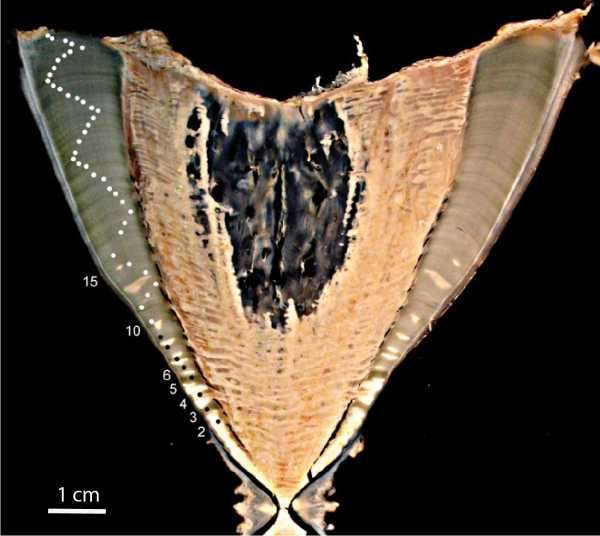
A whale shark vertebra from Pakistan, in cross section, showing 50 growth bands
Whale sharks (Rhincodon typus) are the largest living fish in the world, averaging about 32 feet (10 meters) long and weighing tens of thousands of pounds each. Despite their massive profiles and impressive ranges (whale sharks inhabit all tropical waters on Earth and are thought to migrate enormous distances during mating season), the animals are endangered and have proven very hard to study in the wild.
Scientists still don’t know some very basic facts about whale sharks — for example, how they mate or how long they live. Now, marine biologists are much closer to answering that second question thanks to an unusual biological clock — radioactive carbon left over from Cold War-era nukes.
In a study published today (April 6) in the journal Frontiers in Marine Science, researchers dated carbon-14 — a naturally-occurring type of radioactive carbon that was released into the sky en masse during nuclear weapons tests in the 1950s and 1960s — embedded in the vertebrae of two whale sharks who died long ago in fishing nets in Taiwan and Pakistan. Much like trees, whale shark vertebrae produce growth rings that increase in number throughout the shark’s lifespan; however, until now, scientists had no idea how often those rings actually form, and so have been unable to use them to confirm a given shark’s age.
Enter carbon-14: a type of carbon that occurs naturally all over the world, but became extra-prevalent in the air and ocean after several industrialized nations conducted hundreds of atmospheric nuclear bomb tests last century. Because carbon-14 decays at a steady rate, the study authors were able to look at the subtle differences in the ratio of carbon-14 to other isotopes, or forms, of carbon in each shark’s vertebral growth rings, and therefore figure out exactly how much time had past between the formation of one ring and the next.

Whale sharks are [checks notes] freaking huge. Here, study co-author Mark Meekan swims with one.
“We found that one growth ring was definitely deposited every year,” study co-author Mark Meekan of Australian Institute of Marine Science in Perth, Western Australia, said in a statement. With this knowledge, Meekan and his colleagues were able to confirm the ages of the two dead sharks at 35 and 50 years old, respectively.
Because neither of the two sharks died of old age, those numbers fit in with prior estimates that whale sharks can live incredibly long lives — likely upwards of 100 years, according to one 2017 study of 44 live whale sharks. Further confining the average whale shark lifespan could inform conservation strategies, the researchers said.
“Our study shows that adult sharks can indeed attain great age and that long lifespans are probably a feature of the species,” Meekan added.
“We are hopeful that the demographic data we have provided in this study will help to improve the accuracy of population models and hence, better inform management and conservation efforts for this iconic species,” the study authors concluded in their paper.
Sourse: www.livescience.com





